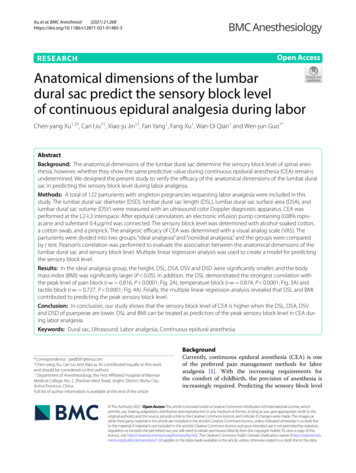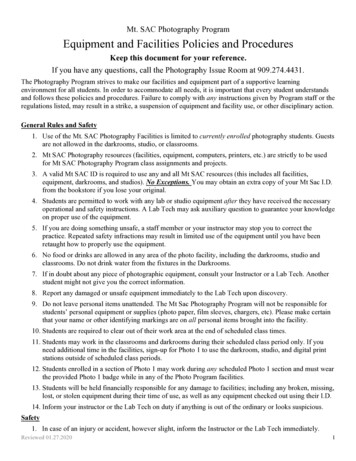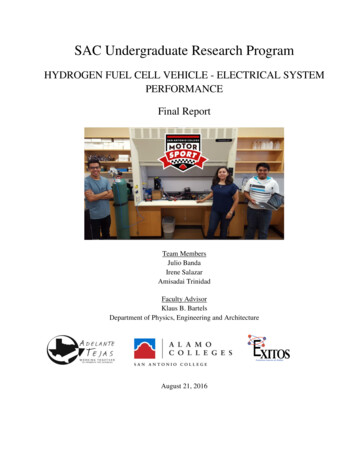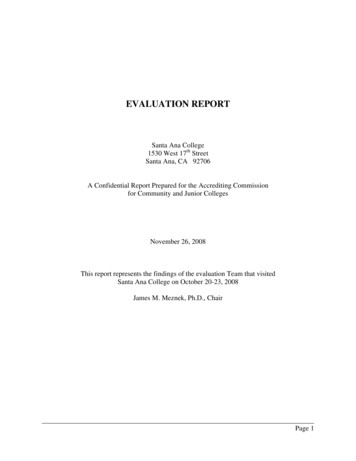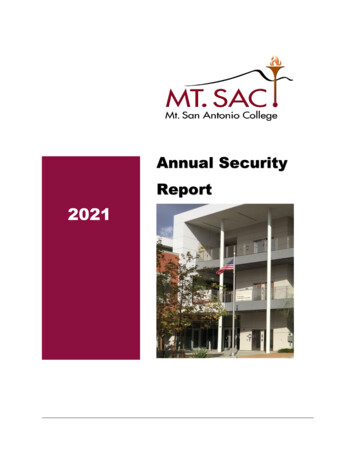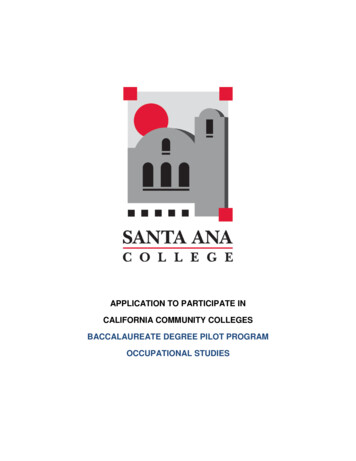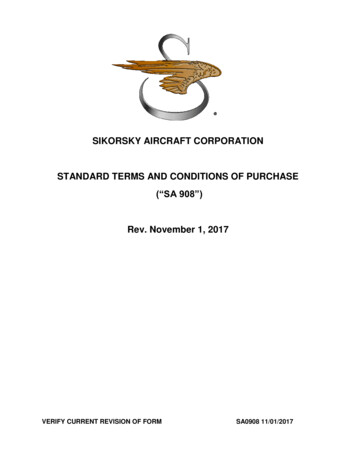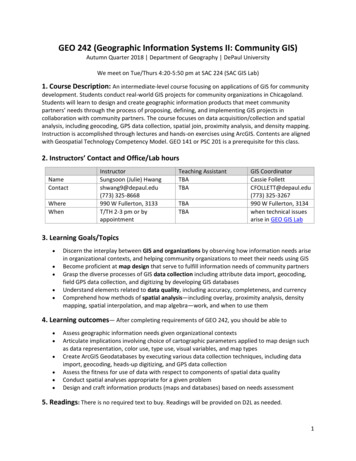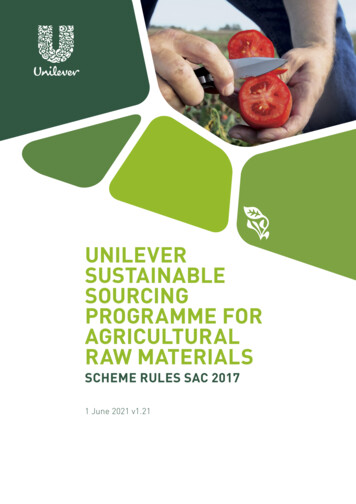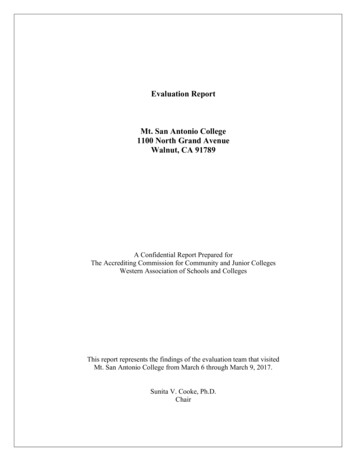
Transcription
Evaluation ReportMt. San Antonio College1100 North Grand AvenueWalnut, CA 91789A Confidential Report Prepared forThe Accrediting Commission for Community and Junior CollegesWestern Association of Schools and CollegesThis report represents the findings of the evaluation team that visitedMt. San Antonio College from March 6 through March 9, 2017.Sunita V. Cooke, Ph.D.Chair
Mt. San Antonio CollegeComprehensive Evaluation Visit Team RosterMarch 6–9, 2017Dr. Sunita V. Cooke (Chair)Superintendent/PresidentMiraCosta College1 Barnard DriveOceanside, CA 92056Mr. Michael Fino (Assistant)Dean, Math and SciencesMiraCosta College1 Barnard DriveOceanside, CA 92056Dr. Wendy BassFaculty Distance Education CoordinatorLos Angeles Pierce College6201 Winnetka AvenueWoodland Hills, CA 91371Mr. Sonny LeomitiDirector of Institutional EffectivenessAmerican Samoa Community CollegeP.O. Box 2609Pago Pago, AS 96799Ms. Christine KeenProfessor of MathCollege of the Sequoias915 S. Mooney Blvd.Visalia, CA 93277Dr. James PattersonProfessor of EnglishImperial Valley College380 E. Aten RoadImperial, CA 92251Dr. Debra DanielsSuperintendent/PresidentTaft College29 Cougar CourtTaft, CA 93268Mr. Robert IsomotoVice President, Business/AdministrationSanta Monica College1900 Pico Blvd.Santa Monica, CA 90405Dr. Robert BellAssistant Superintendent/Senior Vice PresidentNoncredit and Offsite CampusesPasadena City College1570 E. Colorado Blvd.Pasadena, CA 91106Dr. Michael SutliffDean/Kinesiology, Health Science, andAthleticsOrange Coast College2701 Fairview RoadCosta Mesa, CA 92626Ms. Meridith RandallAssociate Superintendent, Instruction, andInstitutional EffectivenessChaffey College5885 N. Haven AvenueRancho Cucamonga, CA 917372
Summary of Evaluation ReportInstitution:Mt. San Antonio CollegeDate of Visit:March 6–9, 2017Team Chair:Sunita V. Cooke, Ph.D.Superintendent/President, MiraCosta CollegeA team of 11 educational professionals made up the accreditation visiting team for Mt. SanAntonio College (Mt. SAC) on March 6–9, 2017. The purpose of the evaluation team visitwas to determine whether the College continues to meet accreditation standards, eligibilityrequirements, commission policies, and United States Department of Education (USDE)regulations. The team evaluated how well the College is achieving its stated purposes,providing recommendations for quality assurance and institutional improvement andsubmitting recommendations to the Accrediting Commission for Community and JuniorColleges regarding the accredited status of the College. In preparation for the visit, the teamchair attended team chair training on December 2, 2016, in Sacramento. The team chair andassistant conducted a pre-visit to the campus on January 18, 2017, and met with thepresident, vice president of instruction/accreditation liaison officer, and administrativeassistants supporting the upcoming comprehensive visit. Nine team members received teamtraining provided by ACCJC staff on January 19, 2017.The evaluation team received the College’s Institutional Self-Evaluation Report (ISER) andrelated evidence well in advance of the site visit. Team members found it to be acomprehensive document that detailed processes used by the College, eligibilityrequirements, commission standards and policies, and USDE regulations. The teamconfirmed that the ISER was compiled through broad participation by the entire Collegecommunity, including faculty, staff, students, and administration. The team found that theCollege provided a very thoughtful ISER and has identified planning items for improvement.The College has identified three areas for continued improvement in quality focus essays.These improvement efforts include integrating key performance indicators (KPI) andinstitutional effectiveness measures into the Planning for Institutional Effectiveness (PIE)processes; implementing guided pathways; and integrating student success, student equity,and basic skills plans.Upon the team’s arrival Monday morning, March 6, 2017, a tour was provided of the singlecollege district in Walnut, CA. Mt. SAC has no other sites where 50 percent or more ofprograms are offered. The team visited with members of the campus accreditation steeringcommittee, at which time discussion took place about upcoming meetings and processes.During the visit, the team conducted approximately 60 formal meetings, interviews, andobservations involving College employees, students, and board members. There was ampletime for less informal meetings and discussions with the College community. Two openforums allowed the team to interact with approximately 134 members of the College3
community (faculty, staff, administrators, and students). The team reviewed numerousmaterials supporting the ISER electronically, which included documents and evidencesupporting the Standards, Eligibility Requirements, Commission Policies, and USDEregulations. Evidence reviewed by the team included, but was not limited to, documents suchas the ISER addendum, institutional plans, program review procedures and reports, studentlearning outcomes evidence, distance education classes, course syllabi, College policies andprocedures, enrollment information, committee minutes and material, and Collegegovernance. The team also viewed evidence and documentation through the College’s portal,and electronic copies stored on a flash drive.The team greatly appreciated the enthusiasm and support from the College employeesthroughout the visit. The team appreciated the assistance of key staff members who assistedwith requests for individual meetings and other logistical needs throughout the evaluationvisit. Campus staff members promptly met every request of the team. The team found anumber of innovative and effective practices and programs, and issued a number ofcommendations to the College. The team found the College satisfies Accreditation Standards,Eligibility Requirements, Commission Policies, and USDE regulations, and issued somerecommendations to increase effectiveness.4
Major Findings and Recommendationsof the 2017 External Evaluation TeamTeam CommendationsDuring the accreditation visit to Mt. SAC, the team recognized several aspects of the Collegeworthy of commendation:1. The team commends the College for data-informed programming responsive to the needsof students such as library hours, the proximity model for tutoring, the bridge programs,and the diversity of support services for targeted populations, including Veterans, Ariseand Aspire.2. The team commends the College for lowering its federal financial aid cohort default ratesto ten percent by voluntarily instituting a default-prevention program, which includesfinancial literacy workshops, loan counseling, and the designation of a staff memberwhose sole responsibility is loan default prevention.3. The team commends the College for effectively integrating a large noncredit program inthe College’s overall student success and governance structures.4. The team commends the College for taking steps towards a more inclusive culture, whichis supported by the development and implementation of the PIE process.5. The team commends the College for successfully completing the rigorous testing toachieve fiscal independence status from the Los Angeles County Office of Education(LACOE).6. The team commends the College for the bold leadership in implementing guidedpathways for the benefit of students.Team RecommendationsAs a result of the external evaluation, the team makes the following recommendations:1. In order to improve and fulfill the intent of the Standard, the team recommends thatstudents receive syllabi in all class sections, which include learning outcomes for thecourse rather than a link to a website that contains the SLO statements. (II.A.3)2. In order to improve, the team recommends that the College develop institutionalprocedures for development, implementation, and evaluation of department-wideexaminations to ensure processes are in place to reduce test bias and enhance reliability.These procedures should include participation of the Institutional Research Department.(II.A.8)3. In order to improve its governance processes and structures, the team recommends thatthe College evaluate the overall governance structure on a regular and continuous basisand use the results as the basis for improvement. (IV.A.7)5
Eligibility Requirements1. AuthorityThe team confirmed that Mt. SAC is authorized to operate as a postsecondary, degreegranting institution based on continuous accreditation by the Accrediting Commission forCommunity and Junior Colleges (ACCJC) of the Western Association of Schools andColleges (WASC). The ACCJC is the regional accrediting body recognized by the USDEand granted authority through the Higher Education Opportunity Act of 2008.The College meets the ER.2. Operational StatusThe team confirmed that the College is operational and provides educational services to29,232 unduplicated student enrollments within degree-applicable credit courses for fall2015. The College has seen an increase in credit full-time enrollment between 2011/12 to2015/16. Approximately 74.8 percent of the students are pursuing educational goals thatrelate to an associate degree and/or transfer.The College meets the ER.3. DegreesThe team confirmed the vast majority of the College courses (78 percent) lead to anassociate degree or transfer. The College offers a variety of programs and 89 of these leadto associate and transfer degrees.The College meets the ER.4. Chief Executive OfficerThe evaluation team confirmed that the Board of Trustees (BOT) employs a president asthe chief executive officer (CEO) of Mt. SAC. The CEO serves as the secretary to theboard and the BOT vests requisite authority in the president to administer board policies.The College meets the ER.5. Financial AccountabilityThe team confirmed that the College engages a qualified audit firm to conduct audits ofall financial records. The College has had unmodified audits for the past six years, and allresults are presented to the BOT and made available to the public.The College meets the ER.6
Compliance with Federal Regulations and Commission PoliciesPublic Notification of an Evaluation Team Visit and Third-Party CommentEvaluation Items:XXXThe institution has made an appropriate and timely effort to solicit third-partycomment in advance of a comprehensive evaluation visit.The institution cooperates with the evaluation team in any necessary follow-uprelated to the third-party comment.The institution demonstrates compliance with the Commission Policy on Rightsand Responsibilities of the Commission and Member Institutions as to third-partycomment.[Regulation citation: 602.23(b).]Conclusion Check-Off (mark one):XThe team has reviewed the elements of this component and has found theinstitution to meet the Commission’s requirements.The team has reviewed the elements of this component and has found theinstitution to meet the Commission’s requirements, but that follow-up isrecommended.The team has reviewed the elements of this component and found the institutiondoes not meet the Commission’s requirements.Narrative:Information regarding the College mission, programs, services, locations, and learningoutcomes are posted in various locations around campus, in catalog and class schedules, andon the College website. Accreditation information is also included on the website. Flyers forprograms with class and certificate information and contact details are also made availableonline and at the College. Two public forums were held on the Mt. SAC campus during theevaluation team visit. These forums were advertised to the public by email and in hard copy,and also through public board meetings. Approximately 134 people attended the two, openforums and shared information about the College.The College has fulfilled third-party notifications. The College has posted the report andinformed the public of the team visit and open forums through email and public boardmeetings. The ACCJC has not received any third-party comments.7
Standards and Performance with Respect to Student AchievementEvaluation Items:XXXXThe institution has defined elements of student achievement performance across theInstitution and has identified the expected measure of performance within eachdefined element. Course completion is included as one of these elements of studentachievement. Other elements of student achievement performance for measurementhave been determined as appropriate to the institution’s mission.The institution has defined elements of student achievement performance withineach instructional program and has identified the expected measure of performancewithin each defined element. The defined elements include, but are not limited to,job placement rates for program completers, and for programs in fields wherelicensure is required, the licensure examination passage rates for programcompleters.The institution-set standards for programs and across the institution are relevant toguide self-evaluation and institutional improvement; the defined elements andexpected performance levels are appropriate within higher education; the results arereported regularly across the campus; and the definition of elements and results areused in program-level and institution-wide planning to evaluate how well theinstitution fulfills its mission, to determine needed changes, to allocating resources,and to make improvements.The institution analyzes its performance as to the institution-set standards and as tostudent achievement, and takes appropriate measures in areas where itsperformance is not at the expected level.[Regulation citations: 602.16(a)(1)(i); 602.17(f); 602.19 (a-e).]Conclusion Check–Off (mark one):XThe team has reviewed the elements of this component and has found theinstitution to meet the Commission’s requirements.The team has reviewed the elements of this component and has found theinstitution to meet the Commission’s requirements, but that follow-up isrecommended.The team has reviewed the elements of this component and found the institutiondoes not meet the Commission’s requirements.Narrative:Mt. SAC has defined elements of student achievement performance across the College andhas identified the expected measure of performance within each defined element. Successfulcourse completion, degree completion, certificate completion (credit, noncredit, careerdevelopment/college preparation [CDCP]), transfer, career and technical (CTE) measures,and fall-to-fall persistence are the elements of student achievement identified by the College.8
These elements of student achievement performance for measurement are appropriate to theCollege mission.Additionally, the College has defined elements of student achievement performance withineach instructional program, and has identified the expected measure of performance withineach of these elements. In programs and fields where licensure is required, the licensureexamination pass rates for program completers are included. The College tracks programcompletion and is still working on more comprehensively monitoring job placement.The institution-set standards (ISS) for programs across the College are relevant to guide selfevaluation and institutional improvement. The defined elements and expected performancelevels are appropriate within higher education. The results of the assessment of data relevantto the ISS are reported regularly across the campus; it is clear that the definition of elementsand results are used in program-level and institution-wide planning to evaluate how well theinstitution fulfills its mission, to determine needed changes, to allocate resources, and tomake improvements.The College analyzes its performance as to the ISS and student achievement, and there havebeen no instances identified where its performance is not at the expected level.Credits, Program Length, and TuitionEvaluation Items:XXXXXCredit-hour assignments and degree-program lengths are within the range of goodpractice in higher education (in policy and procedure).The assignment of credit hours and degree-program lengths is verified by theinstitution and is reliable and accurate across classroom-based courses, laboratoryclasses, distance education classes, and for courses that involve clinical practice (ifapplicable to the institution).Tuition is consistent across degree programs (or there is a rational basis for anyprogram-specific tuition).Any clock-hour conversions to credit hours adhere to the Department ofEducation’s conversion formula, both in policy and procedure, and in practice.The institution demonstrates compliance with the Commission Policy onInstitutional Degrees and Credits.[Regulation citations: 600.2 (definition of credit hour); 602.16(a)(1)(viii); 602.24(e),(f); 668.2; 668.9.]Conclusion Check–Off (mark one):XThe team has reviewed the elements of this component and has found theinstitution to meet the Commission’s requirements.The team has reviewed the elements of this component and has found theinstitution to meet the Commission’s requirements, but that follow-up isrecommended.9
The team has reviewed the elements of this component and found the institutiondoes not meet the Commission’s requirements.Narrative:BP4025, Philosophy and Criteria for Associate Degree and General Education, generallystates the College’s philosophy about depth and general education breadth. The Collegecatalog specifies that for an associate degree, a minimum of 60 degree-appropriate units arerequired with at least 24 units of general education. For an associate of science degree,students must successfully complete all required courses in an approved occupational majorand for an associate in arts degree students must complete a pattern of 18 or more units fromthe courses identified within specific areas of emphasis.AP 4026, Philosophy and Criteria for International Education, states that internationaleducation should encourage programs that support learning about other cultures, globalissues, and the exchange of Californians and international students and scholars.AP 5012 states that International students must complete 12 units of coursework persemester. Currently two study-abroad options are available to students for 12 weeks and 12units.AP 4024 defines a unit of credit as 18 lecture contact hours, plus a minimum of 36 additionalhours of related independent student work, for a total of 54 hours or 54 laboratory or activitycontact hours.The 2016/17 Mt. SAC catalog summarizes that the standard “unit” represents one hour inclass recitation and two hours of outside preparation per week or its equivalent for onesemester. By this definition, “unit’ is synonymous with “semester lecture hour.” In laboratorywork and certain activity courses such as kinesiology, choir, crafting, etc., a greater numberof in-class hours per week is required for each unit of credit. During intersessions, one unit ofcredit represents three hours of lecture per week.The credit hour assignments and degree-program lengths are within the range of goodpractice in higher education.The assignment of credit hours and degree-program lengths is verified by the instructionoffice and the deans and is reliable and accurate across the classroom-based courses, labcourses, distance education classes, and for courses that involve clinical practices such as thenursing program, verified by random checking of the credit course class schedule, andtalking to the deans and the vice president of instruction.Tuition is consistent across degree programs at 46 per unit for California residents and 241per unit for nonresidents.Any clock-hour conversions to credit hours adhere to the Department of Education’sconversion formula. The College’s FAA-approved aircraft maintenance program is the sole10
program using clock hours. Interviews with College personnel and a survey of the classschedule verified the practice.The institution demonstrates compliance with the Commission “Policy on InstitutionalDegree and Credit.”Transfer PoliciesEvaluation Items:XXXTransfer policies are appropriately disclosed to students and to the public.Policies contain information about the criteria the institution uses to accept creditsfor transfer.The institution complies with the Commission Policy on Transfer of Credit.[Regulation citations: 602.16(a)(1)(viii); 602.17(a)(3); 602.24(e); 668.43(a)(ii).]Conclusion Check–Off (mark one):XThe team has reviewed the elements of this component and has found theinstitution to meet the Commission’s requirements.The team has reviewed the elements of this component and has found theinstitution to meet the Commission’s requirements, but that follow-up isrecommended.The team has reviewed the elements of this component and found the institutiondoes not meet the Commission’s requirements.Narrative:The spring 2017 schedule of classes (p. 16) and catalog (p. 17) offers new students withprevious college experiences an opportunity to petition for prerequisite review and approval.The schedule also gives students information on application, new student orientation,placement testing, and educational planning.The 2016/17 College catalog (p. 44) informs students of the residency requirements forconferral of a degree from Mt. SAC. These include a 12-unit residency requirement in thelast semester or a 45-unit residency requirement if the last semester is not at Mt. SAC.The College website informs students to submit all transcripts from any institutions wherecoursework may be applied for conferral of a degree and that they must be on file beforesubmission of the petition for graduation.The 2016/17 College catalog (pp. 23–29) informs students of the ability to useAdvanced Placement, Credit by Examination Program, Military Training, and InternationalBaccalaureate credits toward general education credit and/or CSU admission units.11
A search for “foreign transcript evaluation” revealed a document on the College website thatdefines foreign transcript evaluation and summarizes information from the NationalAssociation of Credential Evaluation Services.12
Distance Education and Correspondence EducationEvaluation Items:XXXXXThe institution has policies and procedures for defining and classifying a course asoffered by distance education or correspondence education, in alignment withUSDE definitions.There is an accurate and consistent application of the policies and procedures fordetermining if a course is offered by distance education (with regular andsubstantive interaction with the instructor, initiated by the instructor, and onlineactivities are included as part of a student’s grade) or correspondence education(online activities are primarily “paperwork related,” including reading postedmaterials, posting homework and completing examinations, and interaction withthe instructor is initiated by the student as needed).The institution has appropriate means and consistently applies those means forverifying the identity of a student who participates in a distance education orcorrespondence education course or program, and for ensuring that studentinformation is protected.The technology infrastructure is sufficient to maintain and sustain the distanceeducation and correspondence education offerings.The institution demonstrates compliance with the Commission Policy on DistanceEducation and Correspondence Education.[Regulation citations: 602.16(a)(1)(iv), (vi); 602.17(g); 668.38.]Conclusion Check–Off (mark one):XThe team has reviewed the elements of this component and has found theinstitution to meet the Commission’s requirements.The team has reviewed the elements of this component and has found theinstitution to meet the Commission’s requirements, but that follow-up isrecommended.The team has reviewed the elements of this component and found the institutiondoes not meet the Commission’s requirements.Narrative:The technological needs associated with distance education are delineated and incorporatedinto technology planning. The Information Technology Department (IT) proactively overseesstudent verification and single sign-on capabilities.Exam proctoring for distance education students is also available online and at the College.College budgetary commitments are consistent and indicative of the College’s support of itsdistance education technology infrastructure.13
The College addresses distance education planning and procedures in its Online EducationPlan, as evidenced by the 2013 Distance Learning Master Plan developed by the DistanceLearning Committee (DLC). This group oversees the integrity of distance education offeringsand clearly specifies the policies and procedures applicable to distance education courses.Interviews with a sampling of distance faculty and a review of distance education coursesconfirm the adherence to stated policies.Student ComplaintsEvaluation Items:XXXXXThe institution has clear policies and procedures for handling student complaints,and the current policies and procedures are accessible to students in the Collegecatalog and online.The student complaint files for the previous six years (since the lastcomprehensive evaluation) are available; the files demonstrate accurateimplementation of the complaint policies and procedures.The team analysis of the student complaint files identifies any issues that may beindicative of the institution’s noncompliance with any Accreditation Standards.The institution posts on its website the names of associations, agencies, andgovernmental bodies that accredit, approve, or license the institution and any of itsprograms, and provides contact information for filing complaints with suchentities.The institution demonstrates compliance with the Commission Policy onRepresentation of Accredited Status and the Policy on Student and PublicComplaints Against Institutions.[Regulation citations: 602.16(a)(1)(ix); 668.43.]Conclusion Check–Off (mark one):XThe team has reviewed the elements of this component and has found theinstitution to meet the Commission’s requirements.The team has reviewed the elements of this component and has found theinstitution to meet the Commission’s requirements, but that follow-up isrecommended.The team has reviewed the elements of this component and found the institutiondoes not meet the Commission’s requirements.Narrative:The College website contains a page entitled Complaints and Grievances that provides anexplanation of the various types of complaints and how one goes about filing a complaint. Italso provides applicable policies and procedures, and much other useful information. Studentcomplaints are managed in an electronic system called OnBase, which contains the previous14
six years (since the last comprehensive visit) of files. The files demonstrate accurateimplementation of the complaint policies and procedures.15
Institutional Disclosure and Advertising and Recruitment MaterialsEvaluation Items:XXXThe institution provides accurate, timely (current), and appropriately detailedinformation to students and the public about its programs, locations, and policies.The institution complies with the Commission Policy on Institutional Advertising,Student Recruitment, and Representation of Accredited Status.The institution provides required information concerning its accredited status asdescribed above in the section on Student Complaints.[Regulation citations: 602.16(a)(1))(vii); 668.6.]Conclusion Check–Off (mark one):XThe team has reviewed the elements of this component and has found theinstitution to meet the Commission’s requirements.The team has reviewed the elements of this component and has found theinstitution to meet the Commission’s requirements, but that follow-up isrecommended.The team has reviewed the elements of this component and found the institutiondoes not meet the Commission’s requirements.Narrative:The College provides accurate information on its website and catalog about its locations,programs, and policies. Information about accreditation is also found in appropriate locationson the website and catalog. The College has fulfilled third-party notifications. The BOT heldpublic meetings on the ISER. The College has posted the report and informed the public ofthe team visit and the open forums where comments were encouraged. The Collegeadvertised the open forums through emails, hard copies, and announcements at public boardmeetings.The ACCJC has not received any third-party comments.Title IV ComplianceEvaluation Items:XXThe institution has presented evidence on the required components of the Title IVProgram, including findings from any audits and program or other review activitiesby the USDE.The institution has addressed any issues raised by the USDE as to financialresponsibility requirements, program record keeping, etc. If issues were not timelyaddressed, the institution demonstrates it has the fiscal and administrative capacityto timely address issues in the future and to retain compliance with Title IV16
program requirements.XXXThe institution’s student loan default rates are within the acceptable range definedby the USDE. Remedial efforts have been undertaken when default rates near ormeet a level outside the acceptable range.Contractual relationships of the institution to offer or receive educational, library,and support services meet the Accreditation Standards and have been approved bythe Commission through substantive change if required.The institution demonstrates compliance with the Commission Policy onContractual Relationships with Non-Regionally Accredited Organizations and thePolicy on Institutional Compliance with Title IV.[Regulation citations: 602.16(a)(1)(v); 602.16(a)(1)(x); 602.19(b); 668.5; 668.15;668.16; 668.71 et seq.]Conclusion Check–Off:XThe team has reviewed the elements of this component and has found theinstitution to meet the Commission’s requirements.The team has reviewed the elements of this component and has found
Taft College 29 Cougar Court Taft, CA 93268 Dr. Robert Bell Assistant Superintendent/ Senior Vice President Noncredit and Offsite Campuses Pasadena City College 1570 E. Colorado Blvd. Pasadena, CA 91106 Ms. Meridith Randall Associate Superintendent, Instruction, and Institutional Effectiveness Chaffey College 5885 N. Haven Avenue
